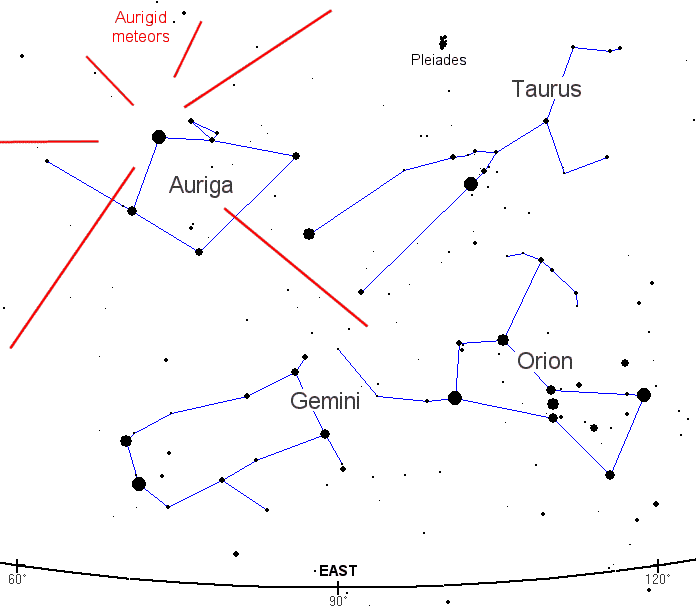The Orionid Meteors are a prolific meteor shower appearing in late
October each year and peaking on the nights of 21-22 October, when the
shower can produce 50-70 meteors per hour, originating in the
constellation of Orion (above and to the right of Orion's right
shoulder). This makes them both one of the more prolific meteor showers,
and one of the easiest for an amateur enthusiast to locate the radiant
of (apparent point of origin).
The radiant of the Orionid Meteors. Astro Bob.
The shower is caused by the Earth passing through the trail of Halley's
Comet (technically Comet P1/Halley), and encountering dust from the tail of this comet. The dust
particles strike the atmosphere at speeds of over 200 000 km per hour,
burning up in the upper atmosphere and producing a light show in the
process.
The Earth does not need to pass close to Halley's Comet for the meteor
shower to occur, it simply passes through a trail of dust from the
comet's tail that is following the same orbital path. Halley's Comet
only visits the Inner Solar System once every 75 years, last doing so in
1986.
See also...
The Alpha Aurigid Meteor shower occurs each year between 25 August and 6
September, peaking between 11.30 pm GMT on 31 August and 0.30 am GMT on
1 September. However the shower is notoriously hard to observe, having
been recorded only in the years 1911, 1929, 1930, 1935, 1979, 1980,
1986, 1994 and 2007 (some of these observations occurred before the
'official' discovery of the shower by Cuno Hoffmeister and Artur
Teichgraeber in 1935, but have subsequently...
The Perseid Meteor shower lasts from late July to early September each
year, and are expected to be at a peak on 12-13 August 2014, slightly
after the Full Moon on 10 August, which may make the meteors harder to
spot than when they occur at darker times of the month. At the peak of
the shower there can be 50-100 meteors per hour. The Perseids...
The Eta Aquarid Meteor Shower will be at a peak on Monday 5/Tuesday 6 May 2014, with up to 45 meteors per hour at it's peak, radiating from the constellation of Aquarius. This does not spend long above the horizon in the northern hemisphere at this time of year, but potentially could produce good shows before dawn on the 4-6 May...
Follow Sciency Thoughts on Facebook.
The Eta Aquarid Meteor Shower will be at a peak on Monday 5/Tuesday 6 May 2014, with up to 45 meteors per hour at it's peak, radiating from the constellation of Aquarius. This does not spend long above the horizon in the northern hemisphere at this time of year, but potentially could produce good shows before dawn on the 4-6 May...
Follow Sciency Thoughts on Facebook.




